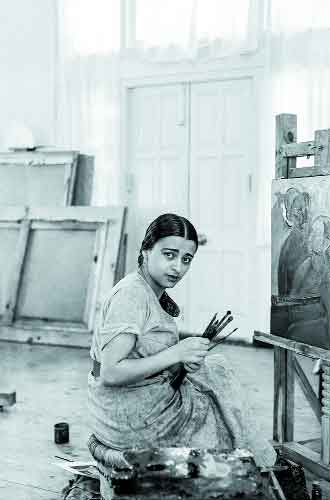Devika Daulat Singh of Photoink stands apart amongst gallery persona in Delhi. She has a quiet sophistication far-removed from other profit-pursuing self-proclaimed curators. At Photoink the finale for 2018 is a historic legacy which belongs to Vivan Sundaram, the nephew of Amrita Shergil. “These are letters and archival material found in an old trunk,” says Devika as she supervises the show’s display. Wakefulness and the Dream State: A Self-Study by Umrao Singh Sher-Gil consists of photographs, drawings and scholia (grammatical, critical, or explanatory comments, either original or extracted from pre-existing commentaries, which are inserted on the margin of the manuscript of an ancient author) from the Sher-Gil Archives is a delight to behold.
Album of archival images
There are small black and white images, typed rumination and letters and reflections from the enigmatic Umrao Singh Sher-Gil’s photographic archive. He was a man with the physique that is both enviable and perfect and his notes tell us about his practice of abstinence, his personal fears and his love for his family members. Indeed once you look closely at his notes as well as the images of Shergil, that are riveting, you know this archive is an album that echoes a parallel legacy. When you study the private nature of its contents you realise that unconsciously Umrao Shergil was every bit a mini-historian in the manner in which he constructed an archive that speaks of a modern proto-postcolonial subject in which the personal and the private both become elegiac emblems.
Shergil’s photographic universe
The Amrita images have about them a haunting gravitas as well as a forlorn, despondent grace that tells us that her father’s photographic universe began and ended with members of his immediate family.
The images tell us also that Umrao was a princely individual who was both a recluse as well as a fastidious eccentric. He was happy clicking self portraits in an age when the world hadn’t heard of such an exercise. Obviously he loved dressing up, kept an impeccable home and seemed to be very much in love with his own image as well as his mirror.
The book on Umrao Shergil published by Photoink tells us that the hundreds of photographs that he took of his family form an extraordinary record of the life and world of an Indo-European family, and are a valuable document in the archives of modernity — in the large sense of that term.
Amrita’s allure
Two images of Amrita call for scrutiny — the artist at her easel, Simla, India, 1937 and Amrita wearing a zari sari Simla, 1936.
The image which shows Amrita momentarily turning away from her easel, paintbrushes in hand suggests a hint of restlessness that shades into something more melancholy than in the more formally posed portraits.
Amrita is always impeccably and exquisitely draped, but appears sometimes wistful, sometimes elusively withdrawn, but nevertheless undeniably beautiful. Clad in a zari sari, she is the epitome of grace.
In his essay Deepak Ananth wrote, “Was it (melancholy) due to a growing sense of isolation that had crept upon her in the years prior to her sudden death in 1941? (The artist alludes to her intellectual solitude in some of her letters.) And yet the pictures she painted at the time hardly indicate a failure of artistic nerve. On the contrary, they suggest that she was poised to become a truly major artist. But that promise was to remain unfulfilled.”
Umrao a pioneer
After reading and studying the prints you know that Umrao Shergil deserves to be feted in history, to be seen as a pioneering figure of Indian photography, an auteur. He had followed Amrita’s self-transformations, probably as beguiled as she was, by the face she presented to the world. And yet many of the photographs taken in the late 1930s disclose a lingering disquiet in her expression. By figuring so centrally in her father’s photographic art, Amrita Sher-Gil helped forge a record of a hybrid culture, one that was nourished by both East and West yet managed to transcend both.
And one wistfully remembers Amrita’s words. “How can one feel the beauty of a form, the intensity or the subtlety of a colour, the quality of a line, unless she is a sensualist of the eyes?”
Writer: Uma Nair
Courtesy: The Pioneer








 OpinionExpress.In
OpinionExpress.In















Comments (0)